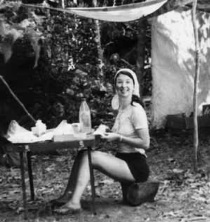Andrée Rosenfeld facts for kids
Quick facts for kids
Andrée Jeanne Rosenfeld
FAHA
|
|
|---|---|
 |
|
| Born | 1934 |
| Died | 2008 |
| Known for | Rock Art Research |
| Scientific career | |
| Institutions | British Museum;Australian National University |
| Doctoral advisor | Frederick Zeuner |
Andrée Jeanne Rosenfeld (1934-2008) was a famous archaeologist. She was an expert in studying ancient rock art, which are drawings and paintings made by people long ago on rocks and in caves. She was also a Fellow of the Australian Academy of the Humanities.
Contents
Early Life and Learning
Andrée Rosenfeld was born in 1934 in Liège, Belgium. Her parents, Yvonne and Léon Rosenfeld, were both physicists. After World War II, her family moved to Manchester, England.
She first studied Physics at Bristol University and earned her degree in 1956. While there, she became interested in caving. Later, she went on to study archaeology. She earned her PhD in 1960 from the UCL Institute of Archaeology. Her special research was about the dirt and rocks found in caves in Devon, England. During her studies, she helped dig at ancient cave sites like Torbryan.
Her Career in Archaeology
After finishing her PhD, Andrée worked as a research assistant at the UCL Institute of Archaeology. Her first book, The Inorganic Raw Materials of Antiquity, showed her skills in understanding ancient materials.
In 1964, she became a curator at the British Museum. A curator is someone who takes care of museum collections. She worked there until 1972, focusing on very old stone tools and objects. She also gave lectures at UCL. During the 1960s, she worked with another famous archaeologist, André Leroi-Gourhan. She was known as an expert in using science to study archaeological finds. She even helped study tiny marks on ancient tools to see how they were used.
Moving to Australia
In 1972, Andrée Rosenfeld moved to Australia with her partner, Peter Ucko. From 1973, she taught at the Australian National University (ANU). This was a new and exciting time for archaeology in Australia.
At ANU, Andrée started important projects for Australian archaeology. She used her scientific training to study rock art. Her digs at the Early Man Site in Queensland found the first proof that rock art in Australia was very, very old, from the Pleistocene Ice Age. She also developed new ways to connect what was found in the ground with the rock art nearby. This was a huge step for rock art research in Australia.
In 1985, she wrote a book about how to protect and save rock art in Australia. Her work looked at both the methods of studying rock art and what the art meant to the people who made it. Later, she focused on understanding the social reasons behind rock art.
Teaching and Retirement
Andrée was a great teacher at ANU. She created courses about the archaeology of art and ancient objects. She also made sure to include ethnography, which is the study of human cultures, into her art lessons.
She was a visiting scholar at the Getty Research Institute in Los Angeles in 1988 and at Oxford University in 1989. She retired from ANU in 1997 and moved to Queensland. She passed away in 2008.
Her Lasting Impact
Andrée Rosenfeld's biggest contribution was in rock art research. She showed how to use scientific methods to study ancient art. People described her as a "careful and kind scholar" and a "fun and skilled teacher."
Many of her students became leading archaeologists themselves, including Jo McDonald and Paul Tacon. Because of her guidance, rock art research in Australia really grew in the late 1980s and 1990s.
Awards and Recognition
The ANU created the Andrée Rosenfeld Chair of Rock Art. This special position honors her important work at the university. A portrait of Andrée is also kept at the National Portrait Gallery in Australia. She was also chosen as a Fellow of the Australian Academy of the Humanities.

